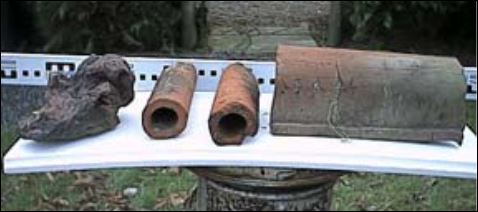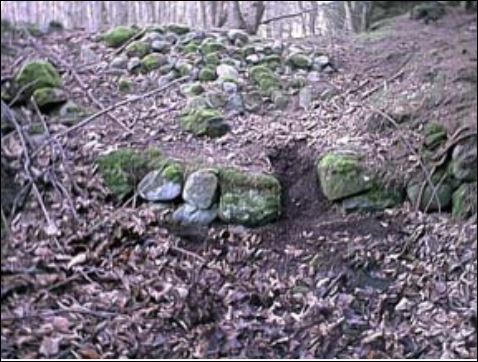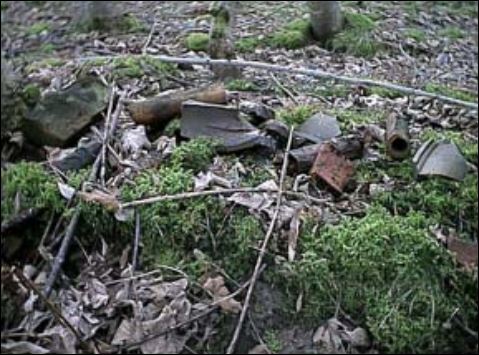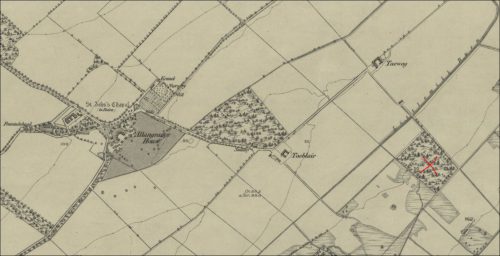Below is a very interesting piece of research by Anthony Neil Morey – Source
An investigation into a former Tileworks at Allangrange, Black Isle by Anthony Neil Morey 2006.
Introduction: The purpose of this investigation was to confirm the verbal account around 1980 by a local resident, now deceased, that a tileworks had existed in a small wooded area close to Taeweg on the Allangrange Estate. It was known, prior to this investigation in 2005, that there was a quantity of broken or deformed clay tiles (drainage pipes) lying on the surface. The site is centred on OS Map Reference NH 6366 5123. It was proposed to determine the history and scale of the works as far as it was possible. Results of the investigation: The former tileworks were confirmed to have existed around 1850. At least four individuals were found by name who had been employed in the tileworks. At the time of reporting it was not possible to confirm the precise dates of operation nor the scope nor scale of the works. There did not appear to be any written record of the works in the public domain. Some estate papers held by St Andrew’s University which may be significant but have not been confirmed as relevant to this investigation. Method of investigation and outcomes. It was decided to investigate the project under six headings:
1. What was produced?
2. Why were the products made?
3. Who was involved?
4. When did the works exist?
5. Where were the works?
6. How did the works operate?
Sources of information are listed at the end of this report.
1. What
Both round and horseshoe-shaped drainage pipes (tiles) have been found in debris heaps. The horseshoe shape was a common type from about 1820 when extensive agricultural improvements were introduced from England or the Borders into the rest of Scotland. The horseshoe-shaped tile would have sat on a flat stone, piece of wood or flat clay tile. Since flat stones are rare in this locality and no flat clay tiles were found, it is possible that the inverts of the drains were timber. The site also contains bricks but it is not possible to tell whether brickmaking took place and whether these bricks were part of the kiln or other buildings. See photo 1 and 3 appended at the end of this report.
2. Why
Major agricultural improvements had already taken place on the Allangrange Estate during the late 18th Century. The estate was commended in the Statistical Account for the
excellence of its works. Local small tileworks were becoming common during the 19th Century. There was a source of clay and water for making bricks. The fuel source is unknown but may have been wood or furze (gorse). For later and larger-scale works coal would probably have been imported.
3. Who
The estate was owned by the Fraser-MacKenzie family. They resided at Allanbank (now known as Allangrange House) although ‘old’ Allangrange still existed but was in a very poor
condition (County Valuation Roll 1865- earlier Valuation Rolls were not available in Council Archives). In the 1851 census the following residents on the estate or at Bogallan (the small crofting township which faced Allangrange on the south side of the valley of the Littlemill Burn) were employed in brick/tile making:
Allangrange:
Henry Douglas Brickmaker
Peter Douglas Brick and Tile Burner
John Douglas Brick and Tile maker
Bogallan:
William Morrison Employed in Tilework
The censuses for 1841 and 1861 and later do not refer to any individuals involved in brick/tile making. There are no Douglases on the estate in 1861 and at Bogallan there is a
William Morrison who is a gardener. This information tends to suggest that the works were complete and the principal operatives had moved on.
4. When
Estate deeds made reference to Government Drainage grants to the estate in the mid-1850s. The Census data suggested that the works were probably only in existence for a relatively short period between say 1850-1860. Some estate papers/ accounts exist at St Andrew’s University. Enquiries regarding their relevance were ongoing at the time of writing. Similarly, requests to the Fraser MacKenzie family for any records have not been acknowledged to date.
5. Where
The site is centred on OS Grid Reference NH 6327 5121. A relatively deep pit had existed until quite recently in the centre of the site (now infilled). The first geological survey shows
a pit near the northwest corner of the site with clay in sand or gravel. This area is generally low lying and would have been marshy prior to the cutting of the deep drainage channels
which carry the Littlemill Burn. The north margin of the site is permanently under standing water. It is not known how deep this water is. There is evidence of peat underlying the
adjacent fields. The clay is a marine deposit from the last ice-age. The works proper are on higher ground to the south. This suggests that the clay would have been quite deep or tending to be underwater. A local agricultural Contractor advised that he had always known the surrounding fields as ‘Tileworks Field’. Another former resident also confirmed that he had played amongst the remains of the works during the 1950s. He thought the works had probably not been worked during the 20th century. No other resident (nor the current owners) had knowledge of the site. The site does not appear on the National Monuments Records. On the first revised OS map(1871) at 1:2500 scale there is evidence of a small rectangular structure, possibly containing water, although there is no specific reference to the site in the survey reference book. This is in roughly the area of the stone-lined pit shown in the photo, appended. The original survey had not been available at the time of writing although a request for a copy of the first survey and any relevant reference has been made. County Valuation Rolls (1865) make no reference to any works. Local newspaper records start after the likely operational dates. Local Council Minutes held in Council Archives have not been accessed.
6. How?
No site-specific information was available to determine the actual methods employed in tile making. Various references ( see appendix) were found which give an indication of
earlier brick and tile works in Scotland and elsewhere. The works would have involved: excavation and transport of the clay:
: mixing/ milling the clay.
: moulding or extruding the products.
: drying the products before firing.
: firing the products.
: storage.
Tile making was a seasonal operation. Milling and mixing would probably have involved a pugmill. Moulding would have required formers. Drying would have been under temporary covers. Earlier kilns were simply clamps or ‘Scotch’ updraught kilns, which were reputedly ‘… wasteful in terms of fuel and damaged produce …’ No artefacts of the operations are evident on the site. It is probable that any extrusion equipment and formers would have been sold or taken to another site. A series of stone-lined pits and heaps of rubble are evident on the site (see photo 2 appended) but their purpose is unknown.
Below – Slag with some fused clayware, 11/4”dia x 14” long round tile, 31/2” int horseshoe tile.

Below – Unidentified stone-lined pit.

Below – Broken clayware debris.

*********************************************************
Allangrange Tileworks – Highland HER Link
**********************************************************
13/12/1849 – Inverness Courier – New brick and tile work – we understand that considerable progress has been made in the erection of a new brick and tile work on the Estate of Sir Evan MacKenzie, Bart, at whose expense the building is proceeding. The site of the new tilework is situated between Allangrange and the village of Munlochy close by the old parish church. It is intended to erect 3 kilns and the first has been founded. The field of clay is believed to be extensive and good and already 40,000 bricks have been made on the spot to be used in building. The plans are by L. Spooner Esq and are very good. Mr Bayne, Inverness is the builder. It is intended to introduce water power to drive the machinery and it is not unlikely that some of the arts of Staffordshire will be introduced as a branch of labour at these new works.
14/02/1856 – Inverness Courier – On Tuesday last, Alexander Mackenzie was tried summarily on a charge of having stolen some of the materials of a wooden shed, part of the Allangrange Tileworks. Mackenzie pled guilty and the Sheriff sentenced him to 7 days imprisonment.
Below – 1872 – The red cross depicts the possible location of the former Allangrange Tileworks which is not detailed on the map.






